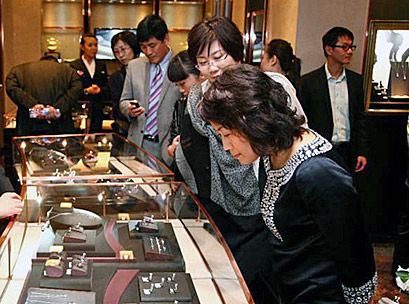Chinese luxury spending has grown the fastest outside of Greater China, at a rate of 31 per cent abroad, says Bain & Company.
Bain’s study showed that weaker Euro and growing overseas travel have pushed Chinese shoppers to make 60 per cent of their total luxury purchases outside the mainland.
The total impact of Chinese spending therefore makes the Chinese consumer the top spender in luxury worldwide, accounting for 25 per cent of total luxury purchases globally.
“Chinese consumers have gone from a developing market to a global segment that the world’s largest luxury brands must address successfully,” said Bruno Lannes, a Bain partner in Greater China.
“Changes in what they want and how they shop are now a central issue for the luxury sector,” he said.
Among Chinese shoppers, Louis Vuitton, Chanel, and Gucci remain in the position of top brands, according to Bain’s research.
Meanwhile, luxury goods sales have slowed in China with only seven per cent growth, a significant drop compared to the 30 per cent achieved in 2011, observes Bain.
The research noticed that the pace of new store openings has slowed, down 20 per cent on 2011. It attributes some of this slowdown to growth concerns, but finds many brands have simply reached their target footprint in China.
The study also discovered five core trends that brands must now address given the global prevalence of Chinese shoppers.
Chinese shoppers from Beijing and Shanghai are shifting to a global mindset of uniqueness, high-quality, and understatement in luxury items. Bain found that 65 per cent of luxury shoppers in Beijing and Shanghai intend to buy fewer items with visible luxury branding, versus 10 per cent outside these two cities.
Younger shoppers (age 25-35) now prefer uniqueness – items that fit their own personality – and mobile and internet for brand communication while older shoppers (age 35-45) remain engaged by status, exclusivity, the in-store shopping experience, and traditional brand marketing.
Chinese shoppers have increased their expectations for a high service level in stores. They also expect the same consumer experience in China as in France and Italy, or risk further deferral of spending to tourism. Bain finds the store experience challenge to be critical for growth in China, with domestic same-store sales now a perennial issue.
Marketing channels are shifting, while luxury e-commerce remains nascent. For Chinese shoppers, the Internet has become an increasingly important as a marketing channel, eclipsing traditional advertising and fashion magazines while the mobile channel is small but growing.
“Brands can take the best advantage of this cooler growth stepping back creating a holistic strategy for Chinese shoppers as a global consumer segment, and delighting them wherever they shop,” said Lannes.
“But the rules are changing. They now face much more pressure to make their offer relevant to many segments of Chinese shopper rather than relying on their luxury status alone,” he concluded.
GB






